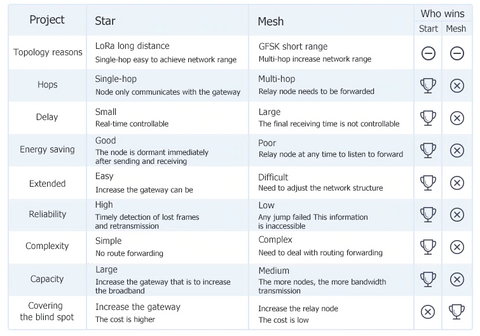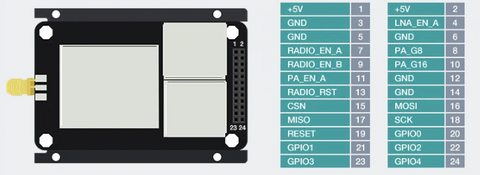
RAK831 Gateway with LoRa® Developer Kit with MAX-7Q GPS
Sign up for restock notifications
What is a RAK831 Gateway Module?
RAK831 is an RF front end of a LoRa® gateway. It is able to receive on different frequency channels at the same time and is able to demodulate the LoRa signal without knowledge of the used spreading factor of the sending node.
This kit contains the RAK831, GPS Antenna, Converter Board, and a LoRa Antenna.
With the compact design, this is an ideal module product to help you realise the whole LoRa® system development. With the USB-SPI converter module FT2232, you can quickly develop the software on your PC. Also, you can integrate the concentrator module in your production products to realise the LoRa gateway function. This is an economical way to address for a huge variety of applications like smart grids, intelligent farming, and other Internet of Things (IoT) applications.
The RAK831 needs a host system like Raspberry Pi or WasAP (OpenWRT based) or WisCam for proper operation. the host processor can be a PC or MCU that will connected to RAK831 via USB or SPI.
Kit Includes
- RAKwireless RAK831
- GPS Antenna
- Converter Board
- LoRa Antenna
Frequency Bands
- 433 Frequency Band: 433MHz - 435MHz
- 470 Frequency Band
- RX: 470MHz - 490MHz
- TX: 490MHz - 510MHz
- EU868 Frequency Band: 865MHz - 872MHz
- AS923 Frequency Band: 923MHz - 925MHz
- AU915 Frequency Band: 915MHz - 928MHz
- US915 Frequency Band: 902MHz - 928MHz
TF Card details
The TF card contains all the necessary drivers and TTN gateway code pre-installed for developers to get their gateways up and running in no time.
Benefits of using this board
- Developers need not go through tons of documents to get their gateway setup. This card has all the software included to start right from day one
- Test commands for gateway components are pre-built and ready to be used out of the box.
- Note: Developers are encouraged to open an account on the TTN website and change the configuration parameters as per need.
Why do we need LoRa gateways?
Public utilities (gas and other instruments, municipal pipelines, street lamps, landfills), large areas of livestock and agricultural irrigation, extensive layout and harsh weather, hydrology, mountain data collection, mines and remote outdoor operations; they suffer from…
- Insufficient signal coverage - low strength and cannot guarantee data stability.
- Power consumption - It is difficult to have a sustainable power supply in harsh environments.
- Low economic efficiency - Low utilization rate, occupation of network resources, high cost.
LPWAN Solution
LPWAn is a very good solution to the above problems
Complex urban environments can transfer 3 km and open area transmissions can be up to 15 km, penetrating harsh environments to transmit signals.
Sleep/low power mode means power consumption is very low
Supports narrowband data transmission resulting in low cost of network communications.
Supports 8 channels (LoRa Gateways create LPWAN IoT Network)
For example, 7 LoRa Gateway modules can cover the Lower Manhattan area
Key Features
- Based on Semtech SX1301
- Sensitivity down to -142.5 dBm
- Frequency bands 433MHz/868MHz/915MHz
- 433MHz with 2x SX1255 as Tx/Rx front ends
- 868/915MHz with 2x SX1257 as Tx/Rx front ends
- USB & SPI interface
- Output power level up to 23 dBm
- Range up to 15 km (Line of Sight)
- RF interface optimised to 50ohm allowing for simple system integration
- Supports 8 channels
- Temperature range from -40 to 85 degrees
- Compact size 80.0 x 50.0 x 5.0mm
- HAL is available form
LoRaWAN
LoRaWAN communication protocol can handle node roaming, base station capacity management, node authentication and other cellular technology requirements, and because of its openness, a large number of R&D companies in the world continuously update and improve the LoRaWAN communication protocol.
Due to the high range a star topology can be used. Compared Star and Mesh topology, we can see the advantages of LoRaWAN on the wireless network.

SX1301 Chip

- Up to -142.5 dBm sensitivity with SX1257 Tx/Rx front end
- 70 dB CW interferer rejection at 1 MHz offset
- Able to operate with negative SNR, CCR up to 9 dB
- Emulates 49x LORA demodulators and 1x (G)FSK demodulator
- Dual digital TX&RX radio front end interfaces
- 10 programmable parallel demodulation paths
- Dynamic data-rate (DDR) adaption
- True antenna diversity or simultaneous dual-band operation
- Any combination of spreading factor and intermediate frequency for up to 8 packets is possible
Pinout Description

Parameter
| Operating Voltage | DC 5V |
|---|---|
| Operating Temperature | -40 to 85 |
| Radio Chipset | SX1301
|
| RF Output Power | 23dbm |
| Input Signal | Not more then -13dBm |
| GPS Receiver | Optional |
| Receiver Sensitivity | Up to -142.5dBm (@293bps) |
| SNR Handling | 9dB |
| Control Interface | SPI |
| Dimension | 80mm*50mm*5mm |
| Firmware | Gateway HAL |
| Range | up to 15KM |
Potential applications
- Wireless Star Networks
- Remote controls
- Smart metering
- Wireless Sensor
- Wireless alarm and security systems
- M2M
- IoT
- Home/Building/Industrial automation
Documentation



